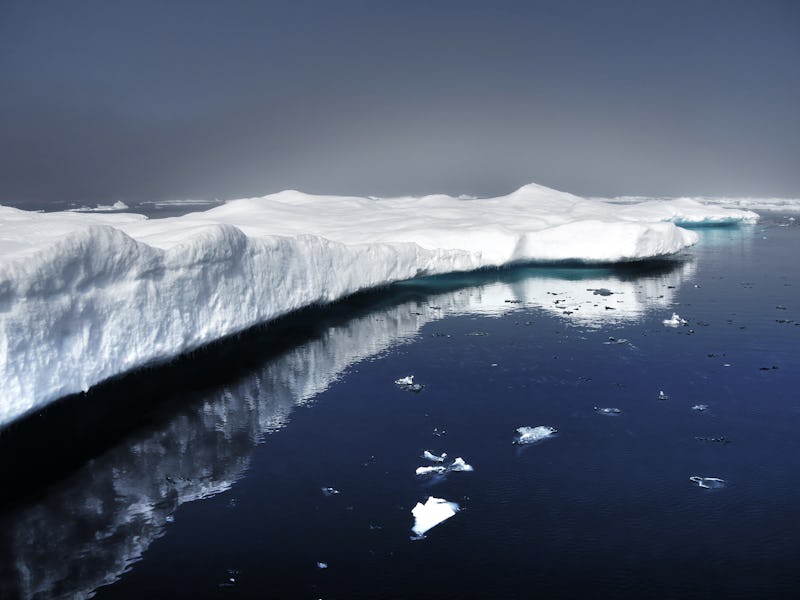Greenland's melting ice sheets may cause "ominous" sea level rise
A new study reveals data on sea level rise, and it's not great news out of Greenland.

Climate change has caused the Arctic to melt at alarmingly fast rates, and the world may not be prepared for the sea level rise we’re about to face. According to new research, scientists predict that Greenland will lose approximately 3 percent of its ice sheet volume likely by 2100, resulting in just over 10 inches of sea level rise.
This sea level rise will happen whether or not we curb global warming in the future, the study says. It’s not great, scientists say, even calling the sea level rise under the worst-case scenario “ominous.”
The findings were published Monday in the journal Nature Climate Change.
How they made the discovery — Previous studies on Greenland’s melting ice sheets have used ice sheet models, which combine observational data with ice sheet models to predict the rate of melting, but these models make it hard to chart future changes in volume with high accuracy.
“Despite its importance for future sea-level rise, our capacity to accurately predict Greenland’s response to climate change is hampered by process limitations in ice sheet models,” write the researchers.
The scientists in the current study tried a novel approach. Based on the satellite and observational data collected, the scientists calculated the changes in the volume of Greenland’s ice sheet, finding that it indeed loses more than it gains — by roughly 3 percent.
Hu Yang, a researcher at the Alfred Wegener Institute Helmholtz Center for Polar and Marine Research, tells Inverse this type of observation-based approach has “significantly fewer uncertainties than the ice sheet model.” Hu was not affiliated with the study.
The researchers analyzed Greenland’s ice melt and subsequent sea level rise under three potential climate scenarios. The first scenario looked at the amount of ice loss Greenland is expected to face based on the average climate data between 2000 and 2019. The second and third scenarios analyzed what sea level rise would look like in two “extreme scenarios” that correspond to the years 2012 and 2018. 2012 was a year of very high ice melt for Greenland, while 2018 was a year of low ice melt.
The Jacobshavn Glacier or Sermeq Kujalleq, pictured here, is the largest glacier outside of Antarctica, draining about 7 percent of the Greenland ice sheet.
What they found — A sea-level rise of a foot might not seem surprising, considering that a recent report by the National Ocean projects a foot of sea level rise — or more — for coastal U.S. cities by 2050.
But the study also examines what would happen if every year going forward later in the century had a similar ice melt to 2012 — a year of significant ice loss for Greenland. The results were far direr: sea levels would rise by at least 782 millimeters — a shocking rise of 2.5 feet.
The researchers call this potential 782-millimeter sea level rise “an ominous prognosis for Greenland’s trajectory through a 21st century of warming.”
And since these findings just looked at the minimum expected sea level rise, the actual amount could be even higher — making Greenland an unpredictable wild card as its melting ice further accelerates the effects of climate change.
“Greenland’s ice sheet will become unstable as a result of ice margin retreat,” Hu says.
A figure from the study projecting the minimum and expected sea level rise from Greenland’s retreating ice sheets.
Why it matters — Greenland’s glaciers span some 1,783,090 square kilometers, making it “one of the largest sources of contemporary sea-level rise,” according to the study.
Hu explains that global warming causes the margins of Greenland’s ice sheets to retreat, therefore “resulting in smaller ice sheets that add water into the ocean and raise sea level.” In short: Our climate is not in harmony with the increasing greenhouse gasses in our atmosphere, which are primarily caused by the burning of fossil fuels.
While a rise of nearly a foot in sea levels “will not seriously affect the world,” according to Hu, the reality is that sea level rise will also be “significantly greater” than that figure since the study only calculates the minimum sea level rise from Greenland’s melting ice sheets.
From Hu’s previous research, we know that it takes a while — even millennia — for Arctic ice sheets to respond to climate change. The researchers in this study did not put a timeframe on their results but said the rise in sea level in response to present-day ice loss could occur by 2100. Rising sea levels have been associated with an increase in extreme flooding, which puts billions of people in low-lying coastal and rivers at risk.
Jason Box, lead author of the research and an ice climatologist at the Geological Survey of Denmark and Greenland, says in a press release that “our observations suggest that most of the committed sea level rise will occur this century.”
The results are a sobering reminder that our existing greenhouse gas emissions have set into motion a series of chain reactions that cannot be undone, culminating in Greenland’s current predicament.
What’s next — The result shows that we may have baked in a certain amount of ice loss into our future, leading to an inevitable degree of sea level rise. But our actions now can still determine how quickly Greenland’s ice sheets melt and sea level rises — and potentially forestall the much worse outcome of a two-plus-foot rise in sea level.
“Even if we cease warming immediately, this melting cannot be stopped. But our actions will determine how quickly this occurs,” Hu concludes.